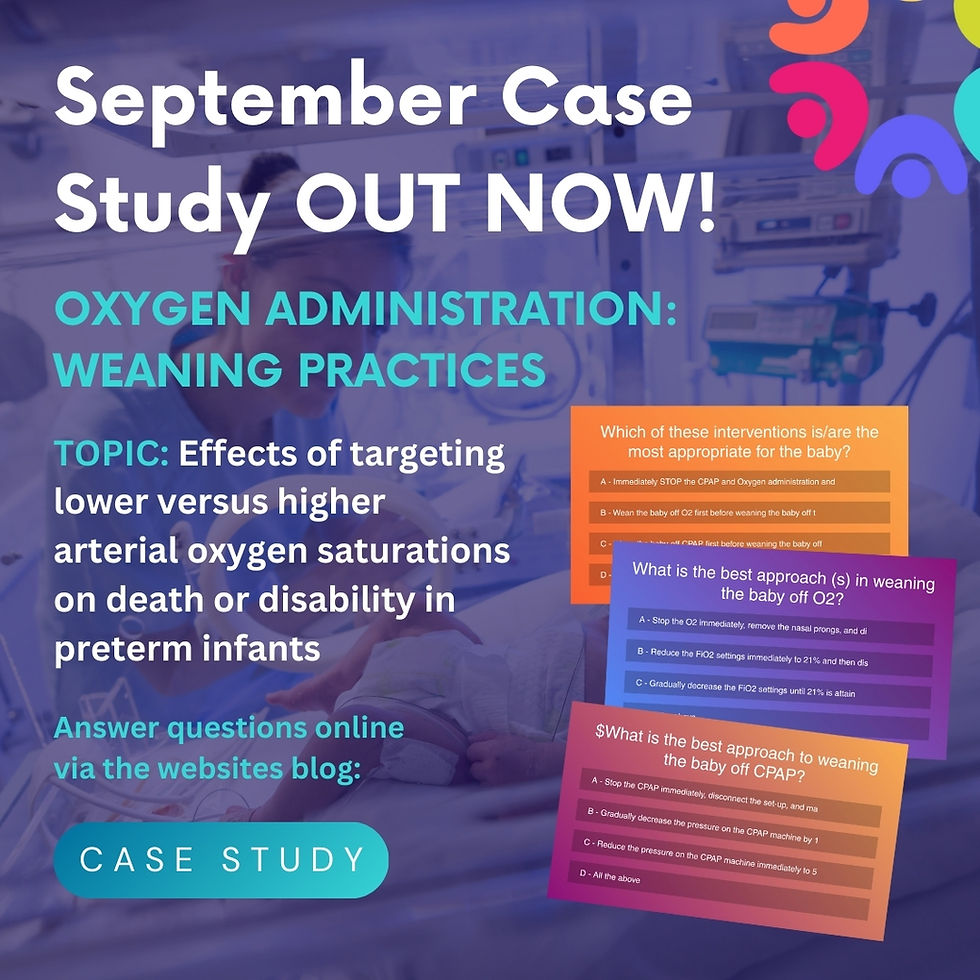September Case Study OUT NOW! - OXYGEN ADMINISTRATION: WEANING PRACTICES
- webwrx
- Sep 10, 2024
- 2 min read

As the lead nurse, you are planning the care of a male preterm infant, 16 days of life, and 16 days of admission in the NICU. The baby was delivered in the hospital via
SVD at 29 weeks gestation on account of PROM lasting 6 hours before birth. Birth weight of 1100g and APGAR score of 7/10 and 8/10 at 1 and 5 minutes, respectively. The baby is managed for respiratory distress syndrome on account of prematurity. Baby is clinically stable, and tolerating feeds well but is still receiving CPAP therapy at 7cmH2O and oxygen supplementation at FiO2 settings of 90% since admission.
Baby’s Vital signs recorded: Temperature = 36.8 o C, HR=124bpm, RR=43cpm,
SPO2=98% on CPAP, and respiratory distress score (Silverman and Anderson
Score) =0
Which of these interventions is/are the most appropriate for the baby?
A - Immediately stop CPAP and oxygen, then disconnect.
B - Wean off O2 first, then wean baby off CPAP.
C - Wean off CPAP first, then wean baby off O2.
D - Both b and c.
What is the best approach (s) in weaning the baby off O2?
A - Stop O2 immediately and remove nasal prongs.
B - Reduce FiO2 to 21%, then discontinue O2.
C - Gradually decrease FiO2 to 21%, then disconnect.
D - All the above.
What is the best approach to weaning the baby off CPAP?
A - Stop CPAP immediately, disconnect, and maintain O2.
B - Gradually decrease CPAP pressure to 4-5cmH2O, then stop.
C - Reduce CPAP pressure to 5cmH2O, then discontinue set-up.
D - All the above.
EVIDENCE CORNER
TOPIC: Effects of targeting lower versus higher arterial oxygen saturations on death or disability in preterm infants
Askie, L. Ml, Darlow, B A., Davis, P. G., Finer, N., Stenson, B., Vento, M., Whyte, R.
Author Conclusion: This study examined a meta-analysis of five randomized trials that
demonstrated no significant difference in the primary composite outcome of death or major
disability in extremely preterm infants when targeting a lower (SpO₂ 85% to 89%) versus higher (SpO₂ 91% to 95%) oxygen saturation range. In comparison when they compared the higher target to lower target, there was a significant increase in the incidence of death at discharge and at 18-24 correct gestational age, and necrotizing enterocolitis. It was demonstrated that the lower range significantly decreases the incidence of retinopathy of prematurity. There were no significant differences between the two treatment groups for major disability, including blindness, severe hearing loss, cerebral palsy, or other significant neonatal morbidities.
Citation: Askie LM, Darlow BA, Davis PG, Finer N, Stenson B, Vento M, Whyte R. Effects of targeting lower versus higher arterial oxygen saturations on death or disability in preterm infants. Cochrane Database of Systematic Reviews 2017, Issue 4. Art. No.: CD011190. DOI:
10.1002/14651858.CD011190.pub2. Accessed 08 September 2024.




very interesting topic. thank you
The improvised CPAP, they say can cause more harm than good. Can it be elaborated for us??
Thank you
Thank you
Interested!